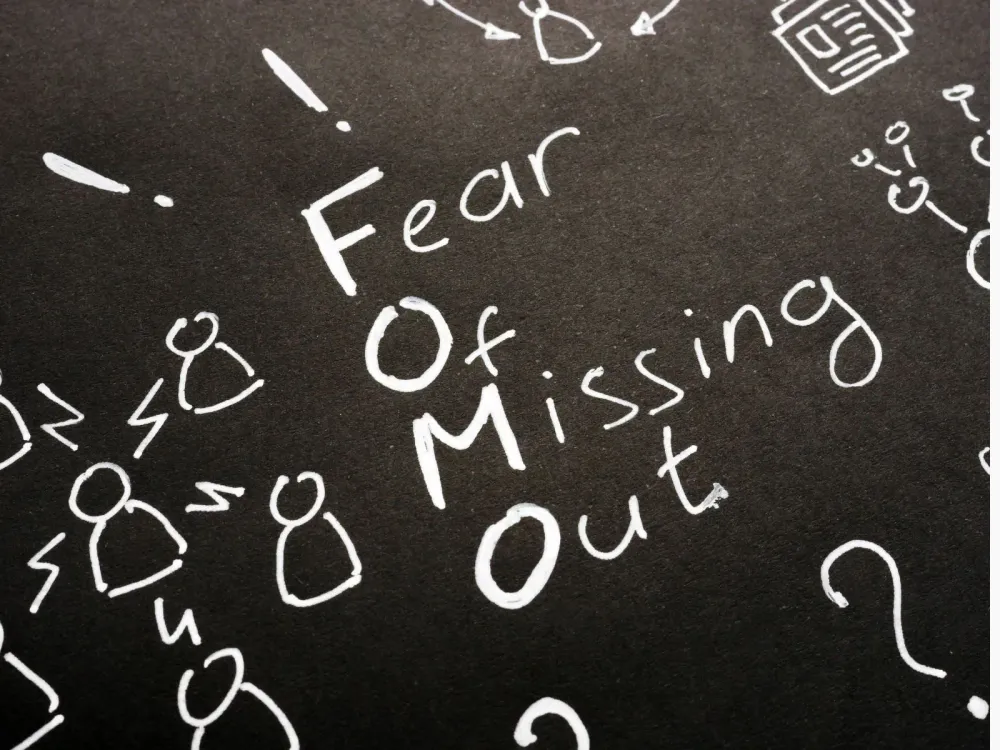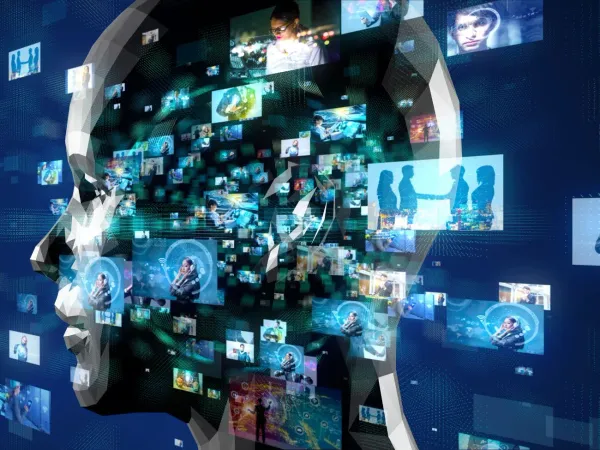
Illustration of 'fear of missing out' concept, with 'missing out' written on a blackboard.
FOMO – good for business, bad for mental health. How can we flip the trend?
FOMO – ‘the fear of missing out’, is one of the principal drivers of modern consumer-based B2C (business to customer) economic models. With contemporary levels of digital acceleration in our ever-increasingly complex lives, everyone nowadays needs to keep up with digital adoption just to achieve basic day to day activities.
For example, it’s now very difficult to travel on a train without having an app that proves you paid the fare. At many railway stations it’s almost impossible to purchase a paper ticket, so to get from A to B you need some kind of digital device or risk a hefty fine.
British author and journalist Matt Haig, who has sold over three million books worldwide, summed up the way in which modern marketers use and indeed exploit this trend to maximise profits when selling fast moving consumer goods (FMCG). In his 2015 book ‘Reasons to Stay Alive’ he wrote:
"The world is increasingly designed to depress us. Happiness isn’t very good for the economy. If we were happy with what we had, why would we need more? … How do you get them [consumers] to buy a new smartphone? By making them feel like they are being left behind.”
In effect, we can see how digital acceleration and FOMO is compelling us, nay forcing us, to purchase the latest gadget or product.
Many people, especially digital laggards and older generations, have to be dragged kicking and screaming into this brave new world of technology. That’s because those of a certain age can remember life before the internet. Sure, less stuff got done, but people were much more happy in their ignorance, largely because they didn’t know about all the depressing stuff that was going on in the world before global social media rammed it down their throats, 24/7/365.
Good for business AND good for mental health
But what if there was a way of making digital adoption easy and stress free to use all this new technology without it feeling depressing and such schlepping hard work? A significant barrier to adopting new technologies is the often-difficult process of learning what to tap or click at the right time to do anything - from turning on your central heating to ordering a scrummy pizza. And, yes, folks, pineapple IS acceptable!
The good news is that artificial intelligence (AI) can now be used to assist people to learn new tech processes and workflows by running a Digital Adoption Platform (DAP) alongside the primary software that they’re trying to master. If people could happily use new tech within minutes of purchasing it, that’s got to be good for our general mental health AND the economy. Sales of new software and devices would doubtless increase if their adoption was seamless and friction-free.
Indeed, society would certainly benefit. It has been shown that the concept of being ‘digitally isolated’ can significantly hinder people’s progress in the world on many levels.
‘Dapping’ your toe in the water!
A DAP is a simple concept that deals with a very complex problem. In short, a DAP can be cloud-based, and works on a per-user basis, hyper personalising its output to each individual software or app user, rather than taking a ‘blanket’ approach.
Some people reading this might remember the infuriatingly annoying virtual assistant ‘Microsoft Clippy’ a 1990s personified paper clip that popped up any time you made a mistake or doing anything ‘unusual’ when using Microsoft Office products. If you started right-justifying lines of text, ‘Clippy’ the illegitimate little busybody, would pop up in MS Word to say “Hi! It looks like you’re writing a letter. Would you like some help?”
After this happened every time you tried to write a letter, the answer from many people was always squarely in the negative – involving a four-letter word which can’t be repeated here!
But the problem was, if you turned ‘Clippy’ off, you would receive no help at all.
By contrast, a DAP learns each individual person’s habits when they use software, and once it was satisfied that you know how to format the recipient address for a letter, it would stop reminding you. Thus, if a husband and wife in their sixties shared a laptop, and the man was nowhere near as tech-savvy as his spouse, the DAP would offer the appropriate level of assistance to each device user dependent upon who was logged in.
In effect, a DAP is like having a friendly and knowledgeable personal assistant sitting at your shoulder, who only offers help when they know it’s required. As the device user becomes more adept at the workflow of apps or whatever, the DAP appears less and less. In a perfect world, digital exclusion would be eradicated. A DAP would appear regularly to help users adopt new technologies, and after a few weeks or even days, it would remain perfectly quiet in the background. People would forget that the DAP was even installed.
A change would do you good
Sheryl Crow, the American singer-songwriter wrote a song back in 1996 entitled ‘a change would do you good’ – and it’s true that as Einstein once said: “the ability to change is a measure of intelligence”.
But even clever people find some digital adoption to be a difficult process. There are those ‘early adopters’ who embrace new technology even if they don’t know why (and let’s be honest, lots of them are Apple geeks!). There are those who just go with the flow, and others who would rather go to the dentist for root canal surgery than upgrade their phone!
By enjoying the benefits of DAPs, if and when such technology becomes more commonplace, that’s got to be a win/ win for everyone in society.


